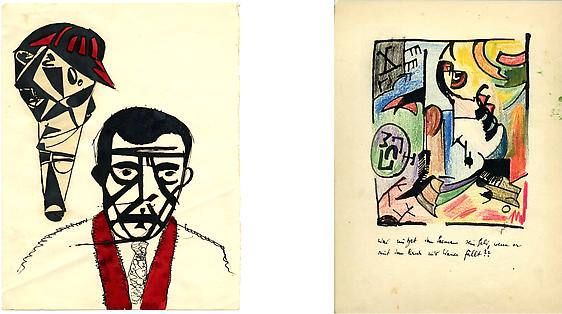ERWIN BLUMENFELD
(1897-1966)
May 5th – July 22nd, 2006
Born in Berlin in 1897, Blumenfeld was taking photographs by the time he was eleven. The first stirrings of Dadaism were an early influence on his emerging talent. Following the First World War Blumenfeld married and spent seventeen years in Holland raising a family and developing his photographic skills. He moved to Paris in 1936, and his first exhibition was held there in March. After the German Invasion he was interned in French concentration camps, but managed to emigrate to the United States in 1941.
After the war Blumenfeld’s career flourished, with his work adorning the covers of Look, Life, Harper’s Bazaar and Vogue. He became the highest paid freelance photographer in New York, but still preferred to be identified as an amateur so that he might choose those subjects which most attracted him – landscapes, sculpture, architecture and, above all, women.
Blumenfeld summed himself up by saying “My life began with the discovery of the magic of chemistry, the interplay of shade and light and the double-edged problem of positive and negative.” He tackled his obsession with women by declaring “How seriously I take beauty! All my portraits reflect my vision. The artist lives on variations of a single theme.”
Erwin Blumenfeld died in Rome in 1969.
Blumenfeld’s collages reveal a man of extraordinary irony, humor, whimsy and inventiveness. While extremely personal, they contain a great deal of subtle social commentary and an occasionally overt and powerful political message. They also reveal a hint of the visual innovation, which later made famous his fashion photographs created for Vogue, Harper’s Bazaar, Helena Rubenstein and Elizabeth Arden, among others. His friend George Grosz influenced Blumenfeld’s early collages, but they illustrate his own graphic and calligraphic talents. Blumenfeld was also a fervent admirer and friend of the celebrated photomontages, John Heartfield, and made a seminal impact on his closet friend and sometimes rival, Paul Citroen, to whose cousin he was married. Blumenfeld, signing his name “Jan Bloomfield,” was the self-appointed chairman of “Holland-Dada” (whose only “members” were Blumenfeld and Citroen). Most of Blumenfeld’s collages were made in Amsterdam, a city cut-off from the Dada activities in Zürich, Berlin and Paris. They deal with his major obsessions: sex, women, religion, death and self. They also shed much light on his irreverence: his admiration and contempt for the church; although a Jew, his fascination with nuns; and his antipathy for the art establishment of his day.
Blumenfeld’s collages have been the subject of numerous museum and gallery exhibitions worldwide and are represented in two of the richest museum Dada collections: the Israel Museum (Jerusalem) and the Kunsthaus Zürich.
Born in Berlin in 1897, Blumenfeld was taking photographs by the time he was eleven. The first stirrings of Dadaism were an early influence on his emerging talent. Following the First World War Blumenfeld married and spent seventeen years in Holland raising a family and developing his photographic skills. He moved to Paris in 1936, and his first exhibition was held there in March. After the German Invasion he was interned in French concentration camps, but managed to emigrate to the United States in 1941.
After the war Blumenfeld’s career flourished, with his work adorning the covers of Look, Life, Harper’s Bazaar and Vogue. He became the highest paid freelance photographer in New York, but still preferred to be identified as an amateur so that he might choose those subjects which most attracted him – landscapes, sculpture, architecture and, above all, women.
Blumenfeld summed himself up by saying “My life began with the discovery of the magic of chemistry, the interplay of shade and light and the double-edged problem of positive and negative.” He tackled his obsession with women by declaring “How seriously I take beauty! All my portraits reflect my vision. The artist lives on variations of a single theme.”
Erwin Blumenfeld died in Rome in 1969.
Blumenfeld’s collages reveal a man of extraordinary irony, humor, whimsy and inventiveness. While extremely personal, they contain a great deal of subtle social commentary and an occasionally overt and powerful political message. They also reveal a hint of the visual innovation, which later made famous his fashion photographs created for Vogue, Harper’s Bazaar, Helena Rubenstein and Elizabeth Arden, among others. His friend George Grosz influenced Blumenfeld’s early collages, but they illustrate his own graphic and calligraphic talents. Blumenfeld was also a fervent admirer and friend of the celebrated photomontages, John Heartfield, and made a seminal impact on his closet friend and sometimes rival, Paul Citroen, to whose cousin he was married. Blumenfeld, signing his name “Jan Bloomfield,” was the self-appointed chairman of “Holland-Dada” (whose only “members” were Blumenfeld and Citroen). Most of Blumenfeld’s collages were made in Amsterdam, a city cut-off from the Dada activities in Zürich, Berlin and Paris. They deal with his major obsessions: sex, women, religion, death and self. They also shed much light on his irreverence: his admiration and contempt for the church; although a Jew, his fascination with nuns; and his antipathy for the art establishment of his day.
Blumenfeld’s collages have been the subject of numerous museum and gallery exhibitions worldwide and are represented in two of the richest museum Dada collections: the Israel Museum (Jerusalem) and the Kunsthaus Zürich.


